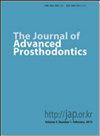冲洗时间和方法对立体光刻义齿基托精度的影响
IF 2.7
3区 医学
Q1 DENTISTRY, ORAL SURGERY & MEDICINE
引用次数: 1
摘要
目的:研究不同冲洗时间和冲洗方式对立体光刻义齿基托树脂正确率和精度的影响。材料与方法制备90个透明的光聚合物树脂样品,根据清洗次数和方法分为9组(n = 10)。所有标本用99%异丙醇清洗5、10和15分钟,采用自动清洗、超声波清洗和手洗三种方法。样品在40℃下聚合30min。为了保证准确性,将扫描到的每个SLA义齿基托凹刻表面采用最佳拟合对齐方法(n = 10)叠加在原始标准镶嵌语言(STL)文件上。为了精确起见,将每组标本中扫描的STL文件凹版面叠加在每个标本上(n = 45)。测量均方根误差(RMSE),采用单因素方差分析和Tukey检验(α < 0.05)对数据进行统计学分析。结果10 min自动组RMSE最低。对于准确性,这与5分钟手洗组的标本有显著差异(P < 0.05)。对于精确度,这与其他组有显著差异(P < 0.05),除了15分钟自动组和15分钟超声组。彩色图谱结果表明,10 min自动化方法凹版表面适应分布最均匀。结论光敏树脂的最佳后处理冲洗时间和方法为自动冲洗10 min和15 min,超声冲洗15 min。本文章由计算机程序翻译,如有差异,请以英文原文为准。
Effect of post-rinsing time and method on accuracy of denture base manufactured with stereolithography
PURPOSE This in vitro study investigates the effect of different post-rinsing times and methods on the trueness and precision of denture base resin manufactured through stereolithography. MATERIALS AND METHODS Ninety clear photopolymer resin specimens were fabricated and divided into nine groups (n = 10) based on rinsing times and methods. All specimens were rinsed with 99% isopropanol alcohol for 5, 10, and 15 min using three methods-automated, ultrasonic cleaning, and hand washing. The specimens were polymerized for 30 min at 40℃. For trueness, the scanned intaglio surface of each SLA denture base was superimposed on the original standard tessellation language (STL) file using best-fit alignment (n = 10). For precision, the scanned intaglio surface of the STL file in each specimen group was superimposed across each specimen (n = 45). The root mean square error (RMSE) was measured, and the data were analyzed statistically through one-way ANOVA and Tukey test (α < .05). RESULTS The 10-min automated group exhibited the lowest RMSE. For trueness, this was significantly different from specimens in the 5-min hand-washed group (P < .05). For precision, this was significantly different from those of other groups (P < .05), except for the 15-min automated and 15-min ultrasonic groups. The color map results indicated that the 10-min automated method exhibited the most uniform distribution of the intaglio surface adaptation. CONCLUSION The optimal postprocessing rinsing times and methods for achieving clear photopolymer resin were found to be the automated method with rinsing times of 10 and 15 min, and the ultrasonic method with a rinsing time of 15 min.
求助全文
通过发布文献求助,成功后即可免费获取论文全文。
去求助
来源期刊

Journal of Advanced Prosthodontics
DENTISTRY, ORAL SURGERY & MEDICINE-
CiteScore
4.70
自引率
3.80%
发文量
25
期刊介绍:
This journal aims to convey scientific and clinical progress in the field of prosthodontics and its related areas to many dental communities concerned with esthetic and functional restorations, occlusion, implants, prostheses, and biomaterials related to prosthodontics.
This journal publishes
• Original research data of high scientific merit in the field of diagnosis, function, esthetics and stomatognathic physiology related to prosthodontic rehabilitation, physiology and mechanics of occlusion, mechanical and biologic aspects of prosthodontic materials including dental implants.
• Review articles by experts on controversies and new developments in prosthodontics.
• Case reports if they provide or document new fundamental knowledge.
 求助内容:
求助内容: 应助结果提醒方式:
应助结果提醒方式:


